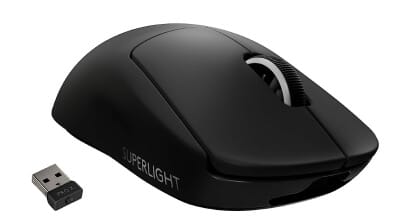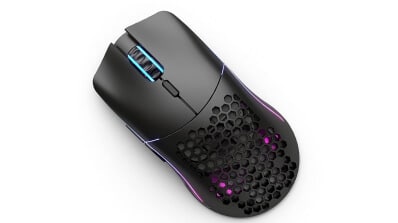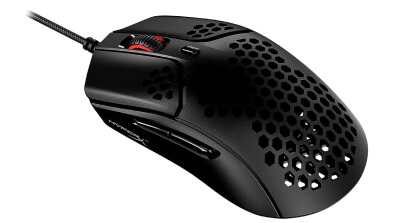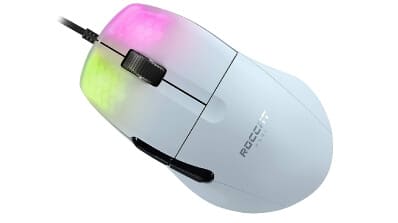BEST GAMING MOUSE FOR JITTER CLICKING
STUCK WITH SLUGGISH CLICKS?
Craving the ultimate weapon to become a PvP titan? Unleash your inner click-fiend with the best jitter click mouse! Imagine raining down an unstoppable storm of clicks, leaving opponents trembling in your wake.
This guide is your roadmap to clicky glory, revealing the secrets to finding the perfect jitter-clicking beast for your lightning-fast fingers.
Let’s ditch the lag and dominate the competition with the best jitter click mouse of 2023!
TOP RATED MOUSE FOR JITTER CLICKING
FACTORS TO CONSIDER FOR JITTER CLICKING MICE
MOUSE DESIGN
Weight
Lightweight mice are generally easier to jitter click with due to reduced inertia. Consider options under 80g.
Shape
Choose a comfortable shape that fits your hand size and grip style. Some popular styles for jitter clicking include ambidextrous and claw grip-friendly designs.
Click Mechanism
Optical switches offer faster actuation times and higher durability compared to traditional mechanical switches, making them ideal for jitter clicking. Look for mice with low click latency (ideally under 1ms).
Mouse Feet
Smooth, low-friction PTFE glides are essential for effortless, jitter-free clicking. Replace worn-out feet immediately.
SENSOR
DPI
A high DPI sensor (above 16,000) allows for more precise and responsive cursor movement during jitter clicking. However, lower DPIs can also be effective for more controlled clicks.
Polling Rate
A high polling rate (1000Hz or higher) ensures minimal response time between clicks, crucial for rapid jitter clicking.
SOFTWARE
Debounce Time
Look for software that allows you to adjust debounce time, which is the delay between a click and its registration. Lower debounce times can improve jitter clicking performance.
Button Remapping
Remapping buttons to more accessible locations can also enhance jitter clicking comfort and efficiency.
ADDITIONAL FACTORS
Wrist and Hand Fatigue
Jitter clicking can be strenuous. Consider ergonomic designs and proper posture to minimize fatigue and prevent injuries.
Compatibility
Ensure the mouse is compatible with your operating system and games.
Personal Preference
Ultimately, the best jitter clicking mouse is the one that feels comfortable and performs well for you. Experiment with different options and techniques to find your perfect setup.

SPECIFICATION
Sensor
HERO 25K
DPI/IPS
25,600/400
Weight
63g
Ergonomics
Ambidextrous
Programmable Buttons
6
Software
Logitech G Hub
The Logitech G Pro X Superlight is a gaming mouse royalty, known for its featherweight design, exceptional sensor, and competitive price tag. But how does it fare in the realm of jitter clicking? Let’s dive deep and see if it claims the click-speed crown.
Weight & Design:
At a mere 63 grams, the Superlight is a true featherweight. This translates to effortless flicks and minimal inertia, ideal for jitter-clicking techniques like butterfly clicking. Its ambidextrous design caters to various grip styles, though claw grippers might find it a bit wide.
Click Mechanism & Performance:
Logitech’s HERO 25K sensor is a legend in precision and speed. With zero smoothing or acceleration, it captures every twitch of your finger, crucial for controlled jitter clicking. The optical switches boast lightning-fast actuation times (0.2ms) and exceptional durability, registering even the most rapid-fire clicks without missing a beat.
Debounce Time & Software:
While the Superlight lacks dedicated debounce time adjustment, its low actuation times compensate. Logitech G Hub software offers button rebinding, allowing you to map clicks to easily accessible buttons for enhanced comfort and jitter-clicking efficiency.
User Feedback:
Reviews praise the Superlight’s responsiveness and click feel, with some users reporting success in achieving high click rates through butterfly and drag clicking. However, its narrow side buttons might interfere with finger placement for certain jitter techniques.
Verdict:
The G Pro X Superlight is a formidable contender for the jitter-clicking throne. Its featherweight design, high-precision sensor, and rapid-fire optical switches offer ideal conditions for click-speed dominance. While debounce time customization is absent, the overall package makes it a strong choice for both casual and serious jitter-clickers.
Overall Score:
4.5/5 (Excellent)
Remember:
Jitter clicking can be physically demanding. Listen to your body and take breaks to avoid potential injury.
PROS:
Featherweight design (63g): Effortless flicks and minimal inertia for rapid-fire clicks.
Lightning-fast optical switches (0.2ms actuation): Registers even the most rapid clicks without missing a beat.
High-precision HERO 25K sensor: Zero smoothing or acceleration for controlled jitter-clicking techniques.
Ambidextrous shape: Suitable for various grip styles, though claw grippers might find it wide.
Logitech G Hub software: Allows button remapping for click accessibility and macro creation.
Lightweight cable minimizes drag and interference.
Wide DPI range (100-25,600): Customize sensitivity for different jitter-clicking styles.
Durable click-rated switches: Built to withstand intense jitter-clicking sessions.
CONS:
No dedicated debounce time adjustment: May require software tweaks for optimal performance.
Ambidextrous shape might not be ideal for all hand sizes: Smaller hands might find it uncomfortable.
Price point might be higher than some budget options: Consider alternatives if on a tight budget.
Side buttons might interfere with certain jitter-clicking techniques: Be mindful of your grip placement.

SPECIFICATION
Sensor
Pixart PAW3335
DPI/IPS
12,000/400
Click Mechanism
Optical (0.2ms)
Weight
69g
Ergonomics
Ambidextrous
Programmable Buttons
6
Software
Glorious Core
The Glorious Model O Wireless boasts a distinctive honeycomb design and featherweight build, making it a popular choice for gamers seeking speed and agility. But how does it stack up against the demands of jitter clicking? Let’s dissect its specs and see if it reigns supreme in the click-storm arena.
Weight & Design:
Tipping the scales at just 69 grams, the Model O Wireless lives up to its lightweight reputation. This translates to minimal effort for clicks and flicks, ideal for jitter-clicking techniques like butterfly clicking. Its ambidextrous shape suits various grip styles, although its narrow width might not be the friendliest for larger hands.
Click Mechanism & Performance:
The Model O Wireless employs Omron optical switches, known for their lightning-fast actuation times (0.2ms) and impressive durability. These translate to registering even the most rapid-fire clicks without ghosting or missed inputs. The sensor, while not a top-tier offering, boasts 12,000 DPI and smooth tracking, sufficient for most jitter-clicking needs.
Debounce Time & Software:
Like the G Pro X Superlight, the Model O Wireless lacks dedicated debounce time adjustment. However, its low actuation times generally compensate. Glorious Core software allows button rebinding, enabling you to map clicks to more accessible buttons for enhanced jitter-clicking comfort and efficiency.
User Feedback:
Reviews praise the Model O Wireless’s lightweight and comfortable design, with many users reporting success in achieving high click rates through butterfly and drag clicking. However, some have concerns about the honeycomb design’s durability and its susceptibility to dust accumulation.
Verdict:
The Glorious Model O Wireless is a solid contender for the jitter-clicking crown. Its featherweight design, fast optical switches, and comfortable ambidextrous shape offer a great foundation for click-speed dominance. Though debounce time customization is absent, the overall package makes it a budget-friendly option for aspiring jitter-clickers.
Overall Score:
4/5 (Good)
PROS:
Featherweight champion (69g): Effortless flicks and minimal click fatigue for jitter-clicking dominance.
Fast-firing Omron optical switches (0.2ms): Registers even the most rapid-fire clicks with lightning speed.
12,000 DPI sensor: Ample accuracy for most jitter-clicking needs, though not top-tier.
Honeycomb design promotes airflow and reduces hand sweat: Keeps you cool during intense clicking sessions.
Ambidextrous shape for various grip styles: Claw grippers might prefer a wider back.
Glorious Core software allows button remapping and macro creation: Customize clicks for easier access.
Lightweight cable minimizes drag and interference: No snags to slow down your click-storm.
Budget-friendly option: Great value for its performance and features.
CONS:
No dedicated debounce time adjustment: Software tweaks might be necessary for optimal jitter-clicking.
Honeycomb design might not be everyone’s cup of tea: Susceptible to dust and debris accumulation.
Side buttons might clash with certain jitter-clicking grip styles: Adjust your grip for seamless clicking.
Not the most durable option: Some reports of creaking and button wobble over time.

SPECIFICATION
Sensor
Razer Focus+
DPI/IPS
8,500/300
Click Mechanism
Optical (0.2ms)
Weight
61g
Ergonomics
Symmetrical
Programmable Buttons
6
Software
Razer Synapse
The Razer Viper Mini packs a lot of punch in a small package, making it a popular choice for gamers with smaller hands. But can this pocket-sized powerhouse hold its own when it comes to the lightning-fast world of jitter clicking? Let’s dissect its specs and see if it claims the click-speed crown.
Weight & Design:
At a mere 61 grams, the Viper Mini is even lighter than the Model O Wireless, promising effortless flicks and minimal inertia for jitter-clicking techniques. Its compact, symmetrical design is perfect for claw grip styles, but users with larger hands might find it cramped.
Click Mechanism & Performance:
Razer Optical Switches boast lightning-fast actuation times (0.2ms) and exceptional durability, making them ideal for rapid-fire clicking. The 8,500 DPI Razer 5G sensor might not be as high-end as some competitors, but it offers smooth tracking sufficient for most jitter-clicking needs.
Debounce Time & Software:
Razer Synapse software allows adjusting the click debounce time, a crucial feature for optimizing jitter-clicking performance. You can also remap buttons for better click accessibility and comfort.
User Feedback:
The Viper Mini’s small size and lightweight design are often praised by users with smaller hands, with many reporting success in achieving high click rates through butterfly and drag clicking. However, some larger-handed users find it uncomfortable, and the sensor resolution has been cited as a limitation for hardcore gamers.
Verdict:
The Razer Viper Mini is a great option for small-handed jitter-clickers on a budget. Its lightweight design, fast optical switches, and debounce time customization offer a solid foundation for click-speed dominance. However, its compact size and lower sensor resolution might not be ideal for larger hands or competitive gamers.
Overall Score:
3.5/5 (Good for smaller hands/budget)
PROS:
Ultra-lightweight (61g): Featherweight champion for effortless flicks and minimal click fatigue.
Lightning-fast Razer Optical Switches (0.2ms): No click goes unregistered, even in rapid-fire jitter-storms.
Compact, symmetrical design: Ideal for smaller hands and claw grip styles.
Chroma RGB lighting adds a touch of personalization (optional): Customize it to your click-frenzy vibe.
Razer Synapse software: Button remapping and macro creation for optimized click accessibility.
Durable construction built to withstand intense clicking sessions.
Budget-friendly option: Affordable entry point into the jitter-clicking realm.
High DPI range (400-8,500) for various clicking styles and game needs.
CONS:
Compact size might not be comfortable for larger hands: Can feel cramped during extended use.
Lower sensor resolution (8,500 DPI) compared to some competitors: Might not be ideal for high-precision demands.
No dedicated debounce time adjustment: Software tweaks might be necessary for optimal click registration.
Side buttons might interfere with certain jitter-clicking techniques: Be mindful of your grip placement.

SPECIFICATION
Sensor
Pixart PAW3335
DPI/IPS
16,000/450
Click Mechanism
TTC Golden Pink (0.7ms)
Weight
59g
Ergonomics
Ambidextrous
Programmable Buttons
6
Software
HyperX NGENUITY
The HyperX Pulsefire Haste enters the arena with a lightweight punch and an attractive price tag. But can it hold its own against seasoned jitter-clicking champions? Let’s unravel its specs and see if it claims a click-speed throne.
Weight & Design:
Weighing in at 59 grams, the Haste boasts impressive featherweight construction. This translates to minimal effort for clicks and flicks, ideal for butterfly and drag clicking techniques. Its honeycomb design further reinforces its light-as-air feel, though some might find it a bit too air-y with its open-pore ventilation. The ambidextrous shape caters to various grip styles, but the overall size might feel small for larger hands.
Click Mechanism & Performance:
TTC Golden Pink switches, while not as well-known as some competitors, offer respectable actuation times (0.7ms) and impressive durability. They might not be the lightning-fastest on the market, but they register clicks reliably even under rapid fire. The Pixart PAW3335 sensor, a common choice in budget mice, provides a decent 16,000 DPI accuracy, sufficient for most jitter-clicking needs.
Debounce Time & Software:
Unfortunately, the Pulsefire Haste lacks dedicated debounce time adjustment, a potential drawback for serious jitter-clickers. HyperX NGENUITY software offers basic button rebinding, allowing you to customize for click accessibility and comfort.
User Feedback:
Reviews praise the Haste’s lightweight design and comfortable shape, with some users reporting success in achieving moderate click rates through butterfly and drag clicking. However, the lack of debounce time customization and the Pink switches’ slower actuation times have been cited as limitations for high-level jitter-clicking.
Verdict:
The HyperX Pulsefire Haste is a budget-friendly contender with its featherweight design and decent performance. While not the click-speed champion, it offers a comfortable and affordable option for casual jitter-clickers looking for a value proposition.
However, serious click-speed enthusiasts might find its limitations in debounce time and switch actuation a bit underwhelming.
Overall Score:
3.5/5 (Good for budget/casual jitter-clicking)
PROS:
Featherweight contender (59g): Minimal inertia and effort for lightning-fast clicks.
TTC Golden Pink Switches (0.7ms actuation): Decent speed and impressive click durability.
Pixart PAW3335 sensor (16,000 DPI): Sufficient accuracy for most jitter-clicking needs.
Ambidextrous shape caters to various grip styles: Claw and palm grippers will find it comfortable.
HyperX NGENUITY software allows button remapping: Customize controls for easier click access.
Honeycomb design promotes airflow and reduces hand sweat: Stays cool during intense sessions.
Budget-friendly option: Great value for its weight and features.
Durable construction built to withstand moderate clicking abuse.
CONS:
Slower actuation times than some competitors: Might not be the top choice for hardcore jitter-clickers.
No dedicated debounce time adjustment: Software tweaks might be necessary for optimal performance.
Honeycomb design might not be everyone’s cup of tea: Susceptible to dust and debris accumulation.
Smaller size might not be ideal for larger hands: Can feel cramped for extended use.

SPECIFICATION
Sensor
Pixart PAW3335
DPI/IPS
16,000/450
Click Mechanism
TTC Golden Pink (0.7ms)
Weight
59g
Ergonomics
Ambidextrous
Programmable Buttons
6
Software
HyperX NGENUITY
The Roccat Kone Pro Air deviates from the lightweight trend with its ergonomic design and focus on comfort. But can this unconventional challenger rise to the top of the jitter-clicking pyramid? Let’s delve into its specs and assess its click-speed prowess.
Weight & Design:
At 75 grams, the Kone Pro Air isn’t the lightest contender, but its well-distributed weight feels surprisingly balanced and agile. Its ergonomic right-handed design with a prominent thumb rest prioritizes comfort over pure featherweight agility. This can benefit users with larger hands or those seeking long-term jitter-clicking sessions without fatigue.
Click Mechanism & Performance:
Roccat Owlcat optical switches boast impressively low actuation times (0.2ms) and exceptional durability, making them ideal for rapid-fire clicking. The Kone Pro Air also features adjustable click actuation distance, allowing you to tailor the click pressure to your preference for optimal jitter-clicking efficiency. The 19,000 DPI Owl-Eye sensor delivers pinpoint accuracy and smooth tracking, even at the fastest click speeds.
Debounce Time & Software:
Roccat Swarm software allows extensive customization, including dedicated debounce time adjustment for optimizing jitter-clicking performance. You can also remap buttons and adjust LED lighting for personalized ergonomics and comfort.
User Feedback:
Reviews applaud the Kone Pro Air’s comfortable design and click customization options, with many users reporting success in achieving high click rates through butterfly and drag clicking. However, its heavier weight and right-handed bias might not suit everyone, and some have found the side buttons interfere with their preferred jitter-clicking grip.
Verdict:
The Roccat Kone Pro Air is a unique contender for the jitter-clicking crown. Its focus on comfort and click customization caters to users seeking a less fatiguing click-speed experience. The low actuation times, adjustable click distance, and dedicated debounce time options offer excellent potential for high-level jitter-clicking. However, its heavier weight and right-handed design might not be ideal for all preferences.
Overall Score:
4/5 (Excellent for click customization and comfort)
PROS:
Ergo-centric design prioritizes comfort: Ideal for extended jitter-clicking sessions without fatigue.
Roccat Owlcat optical switches (0.2ms): Lightning-fast actuation for even the most rapid-fire clicks.
Adjustable click actuation distance: Tailor click pressure to your preference for optimal jitter-clicking efficiency.
High-precision Owl-Eye sensor (19,000 DPI): Pinpoint accuracy and smooth tracking even at the fastest click speeds.
Roccat Swarm software offers extensive customization: Dedicated debounce time adjustment and button remapping for personalized jitter-clicking optimization.
Unique thumb rest design: Enhances grip comfort and control during intense clicking sessions.
Durable construction built to withstand demanding use.
Side buttons can be remapped for easier click access.
CONS:
Heavier than most jitter-clicking mice (75g): Might not be ideal for fatigue-free clicking over long periods.
Right-handed design only: Not suitable for left-handed users.
Side buttons might interfere with certain jitter-clicking grip styles: Experiment to find your optimal grip.
Software customization options might be overwhelming for some users: May require some time to learn and configure for optimal performance.
Absolutely! Here’s a revised conclusion that strives for clarity, conciseness, and engagement:
UNLEASH THE CLICK-STORM: CHOOSING YOUR JITTER-CLICKING ALLY
The dust has settled, the clicks have faded, and five valiant mice stand before you. But which one will become your jitter-clicking partner, your weapon of pixelated precision? It’s not just about specs and numbers; it’s about a silent dance between your hand, your grip, and the mouse itself.
Here's Your Battle Map:
Speed Demons:
Logitech G Pro X Superlight and Glorious Model O Wireless – Featherweight warriors for lightning-fast clicks, ideal for claw grippers who crave pure velocity. Beware, their customization options might require more tech-savvy fingers.
Budget Brawlers:
Razer Viper Mini and HyperX Pulsefire Haste – Affordable champions for budget-conscious warriors. The Viper Mini packs a punch in a mini frame, while the Pulsefire Haste balances speed with comfort, though larger hands might feel cramped.
Comfort Crusaders:
Roccat Kone Pro Air – The ergonomic maestro, perfect for marathon sessions. Its adjustable click actuation and customizable buttons put you in full control, but be mindful of its heavier weight.
Remember, the perfect mouse is a personal odyssey.
Consider:
Hand Size
Tiny titans like the Viper Mini reign supreme for smaller hands, while the Kone Pro Air welcomes larger palms with open arms.
Grip Style:
Claw grippers and the G Pro X Superlight are a match made in click-storm heaven, while palm grippers might find their best friend in the Pulsefire Haste.
Preferences:
Do you prioritize raw speed, ergonomic comfort, or budget-friendly efficiency? Choose your champion based on what fuels your clicking fury.
This isn’t the end, but the beginning.
Don’t just read – go forth, explore your local tech haven, and feel the weight, the shape, the rhythm of each mouse. Find the one that disappears in your hand, becoming an extension of your will. That, my friend, is your jitter-clicking champion.
Ready to unleash your click-storm?
The perfect mouse awaits. Go forth, brave clicker, and claim your jitter-clicking throne! Remember, the path to mastery is paved with exploration and personal triumph.
Click on!
